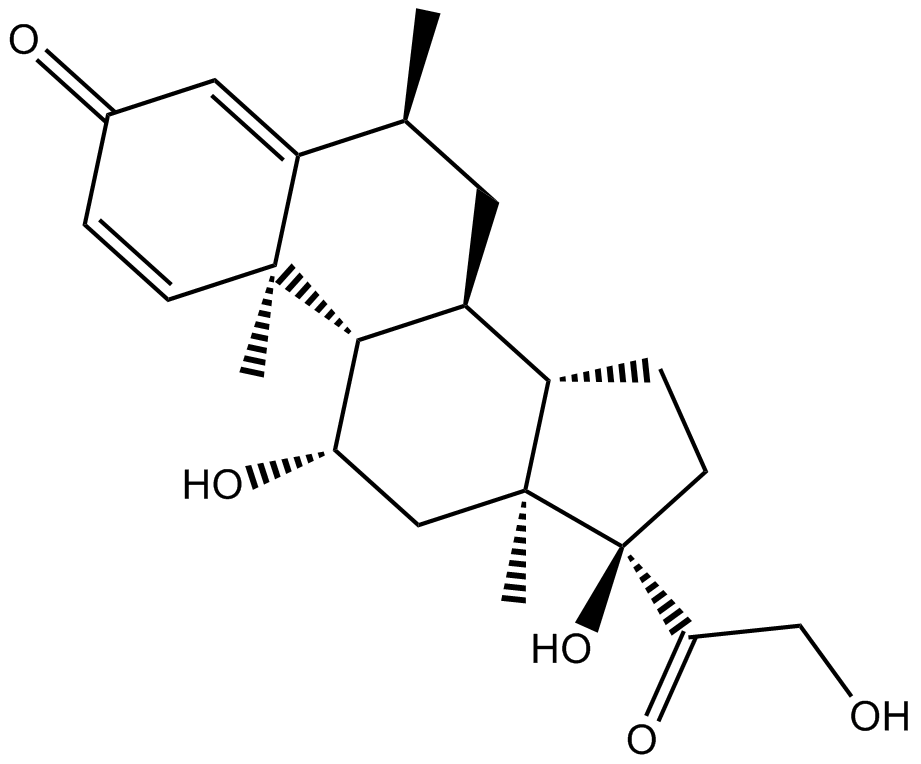Methylprednisolone (Synonyms: Medesone, Medrol, Noretona, NSC 19987, U-7532) |
| カタログ番号GC15505 |
合成副腎皮質ステロイド
Products are for research use only. Not for human use. We do not sell to patients.

Cas No.: 83-43-2
Sample solution is provided at 25 µL, 10mM.
Methylprednisolone is a synthetic glucocorticoid receptor agonist, used to achieve prompt suppression of inflammation.
In vitro: Methylprednisolone (2-10 mg/kg) significantly inhibited TNF production. High doses of methylprednisolone (50 mg/kg) increased LPS-induced IL-10 levels. Methylprednisolone (0.01-100 μg/ml) increased the biosynthesis of IL-10 in LPS-activated mouse peritoneal macrophages [1]. In WG patients and controls, methylprednisolone (MP) down-regulated the spontaneous and the staphylococcal enterotoxin B (SEB)-induced release of chemokines from peripheral blood mononuclear cells (PBMC)[2]. Treatment with 0.25 mM methylprednisolone inhibited acantholysis in skin cultures directly [3].
In vivo: Methylprednisolone (30 mg/kg, i.v.) given immediately after SCI reduced TNF-α expression by 55% (P<0.01) and NF-kB binding activity. Methylprednisolone suppressed the Post-traumatic inflammatory activity caused by TNF-alpha-NF-kB cascade[4]. Intravenously administration of MP (30 mg/kg) reduced the number of ED1-positive cells by 82% in the rostral cord stump and 66% in the caudal stump. In the adult rat, MP administration shortly after spinal cord transection resulted in a long-term reduction of ED1-positive cells and spinal tissue loss, reduced dieback of vestibule spinal fibres, and a transient sprouting of vestibule spinal fibres near the lesion at 1 and 2 weeks post-lesion. MP treatment also significantly reduced the tissue loss in both cord stumps at 2, 4 and 8 week post-injury[5].
Cllinical trials: In patients with acute spinal cord injury diagnosed in National Acute Spinal Cord Injury Study (NASCIS) centers within 8 hours of injury, methylprednisolone treatment for 48 hours improved motor recovery at 6 weeks (P= 0.09) and 6 months (P= 0.07) after injury[6]. In patients with acute spinal-cord injury, methylprednisolone (30 mg/kg) followed by infusion at 5.4 mg/kg/hour for 23 hours improved neurologic recovery. Among patients treated with methylprednisolone (30 mg/kg), mortality at 14 days was significantly increasedsecondary infection[7]. Methylprednisolone has entered clinical trials in patients with severe renel vasculitis and lupus nephritis.
References:
[1] Marchant A, Amraoui Z, Gueydan C, et al. Methylprednisolone differentially regulates IL‐10 and tumour necrosis factor (TNF) production during murine endotoxaemia[J]. Clinical & Experimental Immunology, 1996, 106(1): 91-96.
[2] Torheim E A, Yndestad A, Bjerkeli V, et al. Increased expression of chemokines in patients with Wegener's granulomatosis modulating effects of methylprednisolone in vitro[J]. Clinical & Experimental Immunology, 2005, 140(2): 376-383.
[3] Swanson D L, Dahl M V. Methylprednisolone inhibits pemphigus acantholysis in skin cultures[J]. Journal of investigative dermatology, 1983, 81(3): 258-260.
[4] Xu J, Fan G, Chen S, et al. Methylprednisolone inhibition of TNF-α expression and NF-kB activation after spinal cord injury in rats[J]. Molecular brain research, 1998, 59(2): 135-142.
[5] Oudega M, Vargas C G, Weber A B, et al. [J]. European Journal of Neuroscience, 1999, 11(7): 2453-2464.Long‐term effects of methylprednisolone following transection of adult rat spinal cord
[6] Bracken M B, Shepard M J, Holford T R, et al. Administration of methylprednisolone for 24 or 48 hours or tirilazadmesylate for 48 hours in the treatment of acute spinal cord injury: results of the Third National Acute Spinal Cord Injury Randomized Controlled Trial[J]. Jama, 1997, 277(20): 1597-1604.
[7] Bracken M B, Shepard M J, Collins W F, et al. A randomized, controlled trial of methylprednisolone or naloxone in the treatment of acute spinal-cord injury: results of the Second National Acute Spinal Cord Injury Study[J]. New England Journal of Medicine, 1990, 322(20): 1405-1411.
Average Rating: 5 (Based on Reviews and 30 reference(s) in Google Scholar.)
GLPBIO products are for RESEARCH USE ONLY. Please make sure your review or question is research based.
Required fields are marked with *




















